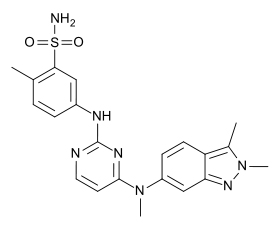Pazopanib/Paclitaxel Combo Active in Refractory, Relapsed Urothelial Carcinoma
Phase II study results found that half of patients with relapsed or refractory urothelial carcinoma responded to treatment with pazopanib and paclitaxel.
Chemical structure of pazopanib

Half of patients with relapsed or refractory urothelial carcinoma responded to treatment with combination pazopanib/paclitaxel, according to the results of a small phase II study presented at the 2015 ASCO Genitourinary Cancers Symposium (Abstract 294) by Sandy Srinivas, MD, of Stanford University Medical Center.
According to Srinivas, metastatic bladder cancer treated with platinum-based combination chemotherapy results in a response rate of between 45% and 55% with a median overall survival of about 13 months, but despite this high response rate, disease relapse is inevitable.
In the United States, there are currently no approved treatments for patients with urothelial cancer who have relapsed. However, many therapies have been tested in the second-line, including an early study of pazopanib, which demonstrated a response rate of 17% as a single agent.
This phase II trial was designed to test pazopanib in combination with paclitaxel. Srinivas and colleagues enrolled 32 patients who had histologically confirmed disease (17 patients with upper urinary tract disease and 15 with primary bladder tumors) that had progressed on up to two prior chemotherapy regimens.
The patients were given 800-mg pazopanib daily with weekly paclitaxel 80 mg/m2 for 3 weeks in a 28-day cycle. The primary endpoint was overall objective response rate. All patients included in the study had multiple metastatic sites, included about one-third who had liver metastases.
Objective responses occurred in 50% of patients, included 3 patients (11%) who had a complete response to study treatment. An additional 11 patients (39%) had a confirmed partial response, and 11 patients (39%) achieved stable disease.
Overall, the four most common side effects were fatigue, diarrhea, nausea/vomiting, and neuropathy.
“We saw very minimal grade 3 or grade 4 toxicities,” Srinivas said. “We had two patients with wound dehiscence and had to come off the trial.”
In addition, myelosuppression was significant, with 44% of patients requiring growth factors to maintain their counts.
Based on the results of this trials, Srinivas and colleagues concluded that this regimen warranted further study.
Newsletter
Stay up to date on recent advances in the multidisciplinary approach to cancer.